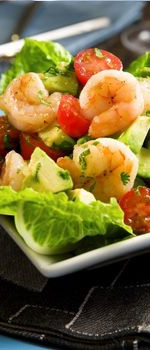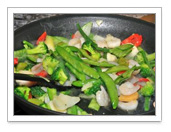
|
Follow Me On: |
 |
Jeannie O'Grady Mortgage Loan Originator, NMLS #209607 Creative Mortgage Lenders, NMLS #247952 Phone: Cell/Text: (727) 542-7001 Fax: (727) 823-0687 License: 209607 Jeannie@CreativeMortgageLenders.com www.CreativeMortgageLenders.com |
 | ||
| ||||
April 2009

|
Wok This Way A Neophyte's Guide to the Perfect Stir-Fry By Kirk Leins
Pretty catchy title, eh? Stir-fries are one of those dishes that most of us love, as long as they're done right, of course. So, how's your stir-frying? Have your attempts at this age-old cooking method yielded less than spectacular dishes? If so, I ask you to read this article carefully. Doing so may just result in a meal fit for an emperor. Identifying The Problem Instead, I would like to address the number of ingredients you're using. Let it be known that when it comes to most stir-fries, less is definitely more. Think about the stir-fry dishes in most Asian restaurants. Combinations such as beef and broccoli, chicken and cashew, and shrimp and snow peas are a few that come to mind. Do you notice how they're all comprised of two main ingredients, usually one protein and one vegetable? The reason for this minimalism is that it keeps the stir-fry focused. Flavors are clean and combinations are on point. It's rather hard to accomplish either of these goals when your stir-fry includes everything but the kitchen sink. The next aspect of a bad stir-fry would be either overcooking or undercooking the ingredients. What you should know is that by taking my advice and limiting the number of main ingredients within each stir-fry, you are dramatically improving your chances for success in this area. It only stands to reason. The more ingredients you use the harder it will be to get them all perfectly cooked. It's Time for a Change First and foremost, in order to pull off a great stir-fry, you need a wok. Regular frying pans are no match for a piece of cooking equipment that's been around for thousands of years. The issue for most home chefs is which wok to buy and where to buy it. Since I could write several articles on the subject of wok selection, I will keep it simple by giving you a few tips to get you started. 1. Look for a wok 14-inches in diameter 2. Look for a wok made from carbon steel 3. Get a handle on the handle 4. Shop smart 5. Purchase a wok that's within your budget A Reason for the Season Put your wok on the stove and turn the heat on high. Fill it with two to three tablespoons of peanut oil and swirl it around. Once the oil starts to smoke heavily, turn off heat. Allow oil to cool and discard all but one tablespoon. With a clean paper towel, rub the remaining oil over the entire inside surface of the wok. It is now seasoned and ready for either cooking or storage. From this point on, dish soap should never touch the cooking surface of your wok. After cooking, simply rinse with hot water and dry with paper towels. Before storing, rub the cooking surface with one tablespoon of peanut oil. This will not only keep it from rusting, but over the course of time it will create one of the best non-stick surfaces known to man. It's Time to Cook 1. Prep ALL of your ingredients before you begin to cook 2. Cook with oils that have a high smoke point BEEF with BROCCOLI and OYSTER SAUCE (serves 3 to 4)
In a medium-sized mixing bowl, combine beef with soy sauce, sherry, sugar and cornstarch. Mix well and marinate for a half hour. Before cooking, drain meat onto paper towels. Place wok on a burner set to the highest heat possible. Once the wok starts to warm, add peanut oil. When oil starts to smoke you're ready to go. Add half of the meat to wok. Using a metal or wooden spatula, move meat around wok until completely browned (about two minutes). Reserve on a plate. Add more oil if needed and allow the wok to get very hot again. Repeat with remaining meat. Return all the meat to the wok and add scallions and garlic. Stir-fry until garlic is fragrant and scallions begin to soften. Mix in oyster sauce and chicken stock. When liquid starts to boil, add the cornstarch and water mixture. The sauce will now start to thicken. Mix in blanched broccoli and cover wok with lid. Turn the heat down to low. Once broccoli is heated through (approximately 1 minute), give it a taste. If necessary, re-season with a touch of soy sauce. If sauce is too thick, add a little more chicken stock. Serve. FISH and BLACK BEAN SAUCE (serves 3 to 4)
In a bowl, combine fish, soy sauce, sherry, sugar and cornstarch. Marinate for 30 minutes. Before cooking, drain fish onto paper towels. Heat your wok and add peanut oil. When oil starts to smoke, add fish to the wok. Using a metal or wooden spatula, move the fish around being careful not to break it apart. Once fish has browned (approximately 45 seconds), remove to a plate and set aside. Allow wok to come back up to temperature and add more oil if needed. Once oil smokes, add onions, bell pepper, celery and mushrooms. Season with salt and stir-fry until vegetables have slightly softened. Add black bean sauce and water and stir to combine. Once the sauce comes together, return fish to wok and allow it to simmer for 30 seconds. Serve. SWEET and SOUR SHRIMP (serves 3 to 4)
For the sauce:
In a medium-sized bowl, mix together all the ingredients for the sauce and set aside. In another bowl, place shrimp and season well with salt and pepper and set aside. Heat a wok over a very high heat and add peanut oil. When oil starts to smoke, add shrimp and quickly stir-fry for one minute or until the shrimp are pink and no longer translucent. Do not overcook the shrimp. Remove shrimp from wok and set aside on a plate. If necessary, add an extra Tbsp of vegetable oil to wok. Once oil starts to smoke, add onion, bell pepper and carrot. Season with a pinch of salt and stir-fry for two minutes or until veggies begin to soften. Add water chestnuts and stir-fry for another 30 seconds. Add reserved sauce to the wok and stir. Once sauce starts to thicken, add cooked shrimp and pineapple. Allow shrimp to warm through and serve. My job here is done. I've given you my best advice on the subject of stir-frying, as well as three great recipes to get you going. All that's left is for you to...wait for it...wait for it...wok this way!
| ||||||||||||||||||||||||||||||
Content provided by Jeannie O'Grady, your reliable and friendly Mortgage Loan Originator. Programs and information are subject to change at any time and without notification. Please consult Broker for details You are receiving a complimentary subscription to YOU Magazine as a result of your ongoing business relationship with Jeannie O'Grady. While beneficial to a wide audience, this information is also commercial in nature and it may contain advertising materials. INVITE A FRIEND to receive YOU Magazine. Please feel free to invite your friends and colleagues to subscribe. SUBSCRIBE to YOU Magazine. If you received this message from a friend, you can subscribe online. UNSUBSCRIBE: If you would like to stop receiving emails from Jeannie O'Grady, you can easily unsubscribe. Creative Mortgage Lenders, NMLS #247952 |
P.O. Box 76482 St. Petersburg, Florida 33734 Powered by Platinum Marketing © Copyright 2024. Vantage Production, LLC. | |||||||||



 Kirk Leins has been cooking his entire life. No stranger to professional kitchens, he currently devotes most of his time to cooking instruction, food writing, and producing television. Kirk also provides his services as a personal chef in and around the Los Angeles area. He has made several TV appearances on both the national and local level, and is the Executive Chef for YOU Magazine. Sign up for Kirk’s free newsletter and cooking blog at
Kirk Leins has been cooking his entire life. No stranger to professional kitchens, he currently devotes most of his time to cooking instruction, food writing, and producing television. Kirk also provides his services as a personal chef in and around the Los Angeles area. He has made several TV appearances on both the national and local level, and is the Executive Chef for YOU Magazine. Sign up for Kirk’s free newsletter and cooking blog at